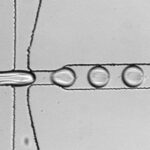Microfluidics
Our focus is on the development of biochemical assays for absorption-based ultra-high-throughput droplet microfluidics. These assays are used, for example, in enzyme engineering experiments to screen particularly large libraries. In addition, we combine droplet microfluidics with synthetic biology methods to identify new enzymes from metagenomes in high throughput

Figure 1: Droplet generation.
Droplet microfluidics can miniaturise biochemical assays from the usual µL scale to the picolitre scale. Droplets are monodisperse droplets that can be automatically produced by thousands per second using microfluidic chips.
The individual droplets function as closed reaction chambers and can be used in a similar way to the individual wells in microtitre plates. Microfluidic chips equipped with detectors can, for example, read absorption signals from droplets. Based on these signals, individual droplets can be sifted in special sorting chips, with a throughput of up to 300 Hz, and specifically isolated for further analysis.
This considerably improves throughput and resource consumption compared to conventional microtitre plate assays.
